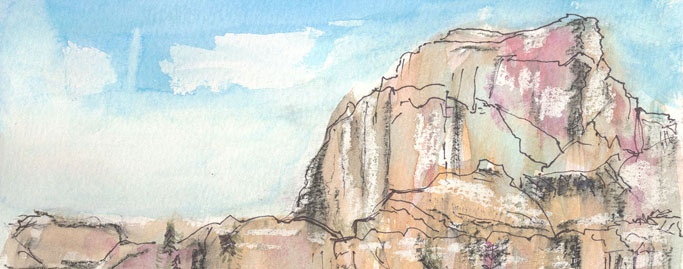Print resources
Link to Bibliography of the Archaeology of Sacred Sites
Good general audience sources for the Verde Valley and Sinagua culture areas:
Good general audience sources for Southwestern Archaeology:
· Life in the Pueblo, by Kathryn Kamp, 1998, Waveland Press. We use this as an undergraduate introductory textbook at NAU. Engaging, entertaining, accurate, and explains clearly how archaeologists know what we know, and how we find out more. Beautiful illustrations by Amy Henderson, an artist who really knows her archaeology.
· Ancient Peoples of the American Southwest, by Stephen Plog, 1997, Thames and Hudson, London. A favorite textbook for undergraduates, highly recommended for graduate students as well as the general public. This book puts the whole of Southwestern prehistory into perspective. It covers the major changes through time throughout the Southwest, and explains differences among the major cultural traditions here.
· Rock Art of the Southwest: A Visitor’s Companion, by Liz Welsh and Peter Welsh, 2000, Wilderness Press. Complete, accurate, “makes you think” discussion of rock art from basic terms to theories about interpretation. Very accessible writing style, well-organized, highly recommended! Includes site etiquette and lots of suggested field trips, including Palatki and V-Bar-V near Sedona.
Good professional/technical sources for Southwestern Archaeology:
· Archaeology of the Southwest, by Linda Cordell, second edition, 1997, Academic Press, New York. This is THE reference book, recommended for advanced readers.
· Emil W. Haury’s Prehistory of the American Southwest, edited by J. Jefferson Reid and David E. Doyel, 1986, University of Arizona Press. Articles by one of Southwest Archaeology’s most revered pioneers, “Doc” Haury.
· When is a Kiva? and Other Questions about Southwestern Archaeology, by Watson Smith, 1990, University of Arizona Press. Watson Smith was simply the best writer and one of the brightest minds in the history of Southwestern Archaeology. Excerpts from some of his best work are collected here. For creative thinking about Hopi and Wupatki, this is good stuff.
· Themes in Southwestern Prehistory, edited by George J. Gumerman, 1994, School of American Research, Santa Fe. This volume pulls together scholars working all over the Southwest to address some of the major, “big” picture themes.
· Women and Men in the Prehispanic Southwest: A Gendered Perspective on Labor, Power, and Prestige,” edited by Patricia Crown. School of American Research Advanced Seminar Series, School of American Research Press, Santa Fe. Best summary of recent scholarship on women’s and men’s roles in the ancient Southwest, including a discussion of Gender Ideology and Ritual Activities, by Kelley Hays-Gilpin, which includes rock art data.
· Children in the Prehistoric Southwest, edited by Kathryn A. Kamp, pp. 196-210. University of Utah Press. Includes “Wearing a Butterfly, Coming of Age: A 1500 Year Old Puebloan Tradition,” by Kelley Hays-Gilpin, about the butterfly hair whorls seen on “maiden figures” in rock art, such as the one at Palatki.
Good professional/technical sources for Rock Art Research:
A Manual for Rock Art Documentation, by Lawrence Loendorf, Linda Olson, Stuart Connor, and J. Claire Dean, 1998.National Park Service and Bureau of Reclamation. Terrific step-by-step guidelines for non-destructive recording techniques, suggestions for photography, good discussion of Tribal Consultation, ethics, and conservation.
Handbook of Rock Art Research, edited by David S. Whitley, 2000, AltaMira Press. A pricey but complete and up-to-date summary of methods and theories regarding rock-art, and summaries of world-wide rock art styles and contexts.
Landscape of the Spirits: Hohokam Rock Art at South Mountain Park, 2002, by Todd W. Bostwick with photographs by Peter Krocek. University of Arizona Press, Tucson. One of my favorite books about rock art because it includes a wide variety of possible interpretations from shamanism to astronomy to sacred landscapes and more. Takes into account the landscape contexts of rock art and other sites. Ethical, responsible use of ethnography (including historic and contemporary Piman stories that help shed light on meaning and context). Readable, with gorgeous photos and drawings.
Good introductory books on archaeological method and theory
Archaeology: The Basics, by Clive Gamble, 2001, Routledge, London. Readable, brief, clear! All the definitions from "artifact" to "zooarchaeology", and all the current theoretical orientations, from recent uses of Marxism to "cognitive archaeology". Well-organized, readable, accurate, and very inexpensive!
Archaeological Theory, An Introduction, by Matthew Johnson, 1999, Basil Blackwell, London. Amusing and up-to-date, with a British flair. Johnson wrote this for undergraduate archaeology majors.
